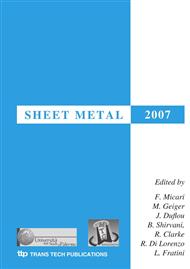p.135
p.143
p.151
p.161
p.169
p.177
p.185
p.193
p.201
Investigation into Thermal Characteristics in Cutting of a Low Carbon Sheet Using a High-Power CW Nd:YAG Laser for Net Shape Manufacturing
Abstract:
The objective of this paper is to investigate the influence of process parameters on kerfwidth and the melted area in sharp corners for cutting of a low carbon (CSP 1N) sheet using a high power Nd:YAG laser with a continuous wave for net shape manufacturing. In order to investigate the effects of the power of laser, the cutting speed of the laser and the thickness of the material on the kerfwidth, several linear cutting tests have been carried out. From the results of experiments, the relationship between the effective heat input and kerfwidth has been obtained. In addition, it has been shown that the kerfwidth ranges from 0.47 mm to 0.79 mm. In order to investigate the influence of the corner angle and size of the loop on the melted area in sharp corners for each cutting condition, angular cutting tests and loop cutting tests have been performed. From the results of angular cutting tests, the relationship between the corner angle and the melted area has been obtained and it has been found that the melted area is nearly zero at the corner angle of 150 o. Through the results of loop cutting experiments, the relationship between the corner angles on the melted area in the corner according to the size of the loop has been obtained. In addition, a proper size of loop for each corner angle has been obtained. The above empirical results have been applied in the development of a knowledge-based path generation program for laser cutting with algorithms of the offset generation and the path modification.
Info:
Periodical:
Pages:
169-176
Citation:
Online since:
July 2007
Authors:
Price:
Сopyright:
© 2007 Trans Tech Publications Ltd. All Rights Reserved
Share:
Citation:


